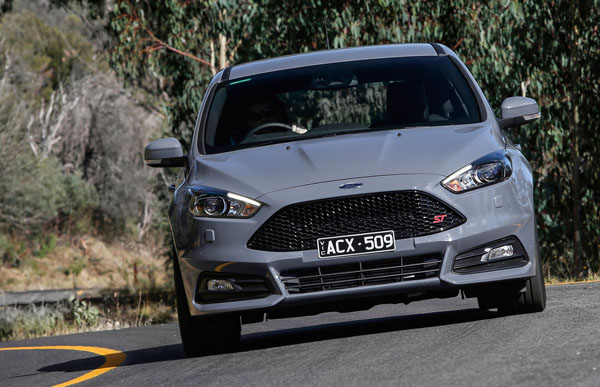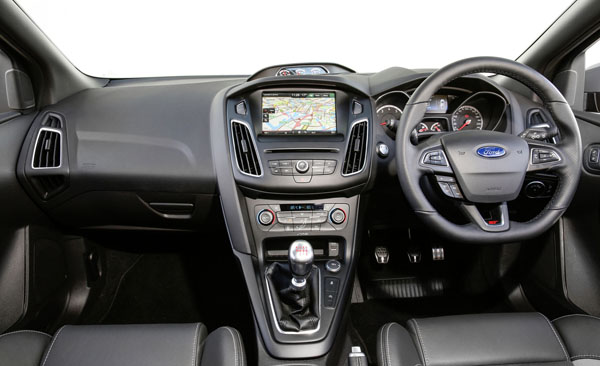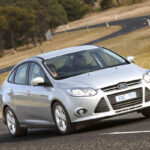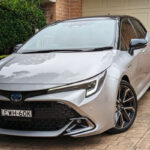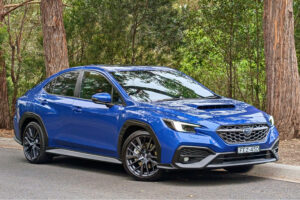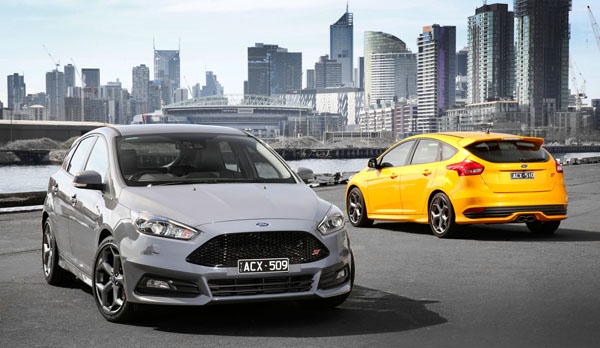
It’s way too early to call time on the ‘hard stuff’ from Ford. The Blue Oval ‘home brew’ – making cars in Australia – may be about to go down the gurgler but there is still plenty of spirit there.
For example, the new Mustang is selling its socks off here; the Falcon is duking it out with arch rival Holden in the V8 Supercar championships – and the new Focus ST is taking it up to the hot hatches of Europe.
The LZ series Focus ST, is the latest in a line of Ford performance hatchbacks and comes with a host of new and reworked features including chassis control technology combined with a re-tuned suspension; sporty looks and revised interior; and Sync2 connectivity with high-resolution 8.0-inch colour touch screen, all for less than $40,000.
Our road test car had the Technology Pack available as an option for an extra $2000, as wells as sporty 19-inch alloy wheels for $1999 more.
STYLING
The Focus ST visually carries many accoutrements of a European hot hatch. As well as a lower, wider stance, Race Red paintwork of the test car put the finishing touches to it. Red front and rear brake calipers peek out from behind new-colour spokes of 18-inch alloy wheels.
A new sculpted bonnet, slimmer headlamps and rectangular foglamps are augmented by body-coloured side skirts, and a rear diffuser flanking twin hexagonal centre exhausts, and a rear roof spoiler.
INTERIOR
Focus ST tradition remains: the three-dial set-up on the top of the dashboard giving the driver info on turbo boost pressure, plus oil pressure and temperature.
There is a new, flat-bottom sports steering wheel with a soft-feel leather covered rim, a satin chrome-capped gear lever and ST pedals.
Satin chrome extends to door grab handles, while illuminated aluminium scuff plates add a nice touch, and sports seats were developed jointly by Ford and Recaro.
INFOTAINMENT
Ford’s Sync 2 connectivity system offers access to audio, navigation, climate control and mobile phones using voice control and a high-definition, 8.0-inch colour touchscreen. The screen divides into quadrants for quick access to information.
ENGINES / TRANSMISSIONS
Focus ST’s 2.0-litre GTDi EcoBoost turbocharged engine pumps out 184 kW of power and 345 Nm of torque (360 Nm for a few seconds with overboost). It’s mated to a six-speed Durashift manual transmission.
SAFETY
Six airbags are part and parcel of a passive safety package, while active safety calls on ABS anti-skid brake system with Electronic Brake-force Distribution and Dynamic Stability Control and Traction Control. Ford also lists Hill Start Assist as a safety item, frankly we feel that anyone who needs this shouldn’t be behind the wheel of any high-performance machine.
Ford’s enhanced Active City Stop, designed to avoid or minimise the impact of a collision, now operates at speeds of up to 50 km/h. It readies the brakes if a potential impact is detected and, if the driver does not respond, automatically applies the brakes. This was not needed during out week’s test, but welcome all the same.
Clever Adaptive Front Lighting, on offer for the first time on Focus ST, adjusts the intensity and angle of the Bi-Xenon HID headlamp beams according to vehicle speed, steering angle and distance to objects to provide optimal illumination.
Enhanced Transitional Stability system, as part of the vehicle’s advanced Dynamic Stability Control system, is designed to sense vehicle stability and driver inputs, then predicts when a skid or loss of control might occur and intervenes using individual wheel braking.
Owners can also take advantage of the aforementioned optional Technology Pack which features Active City Stop, Rear Cross Traffic Alert, Lane Keeping Aid, Lane Departure Warning, Driver Impairment Monitor and Auto High Beam Headlamps.
DRIVING
Ford / Recaro Sports seats, trimmed in contrasting leather, are all very well but there’s a difference between lateral support and cramped conditions. The Focus ST front seats are tight even for a Joe of average girth. They are also too tightly sprung. On test, during an extended run, they received an almost universal thumbs-down from more than one front-seat passenger.
If seating was squeezy, the unbelievably wide 12 metre turning circle made parking in tight spots a waltz of to-ing and fro-ing to fit the car in.
On the whole, the engine worked well with the six-speed manual transmission with shifts recommended on the instrument read-out directly in front of the driver.
The Focus ST also showed its mettle with attractive fuel consumption of 11.6 litres per 100 kilometres shuffling around in town traffic and 6.3 if given its legs on the open road.
It is a sharp and responsive performer. New front springs and sportier new shock absorber tuning front and rear, with stiffer suspension bushes on the front lower control arm and rear spring links, combined with anti-roll bars and rear springs from the previous generation ST doing the trick.
Calibration of the Electronic Power Assisted Steering and electronic vehicle control systems also has been revised to meet the sporting requirements of the new model.
There was much praise for Rear Cross Traffic Alert, especially from the back seat, warning the driver when reversing from parking spaces when it detected other vehicles about to cross behind.
SUMMING UP
The Ford LZ Focus ST is a sharp looker but needs to be lived with to weigh up its seating and parking foibles. Those wishing to ignore these should find it lives up to its sporting hatchback promise. It is possible to spin the wheels, yeah.
AT A GLANCE
Focus ST 2.0-litre hatch: $38,990 (manual)
Technology Pack $2000
Prestige paint $450
Note: These prices do not include dealer or government charges. Contact your local Ford dealer for drive-away prices.
FEATURES
18-inch wheels
ABS anti-locking brakes
Electronic brake-force distribution
Vehicle dynamics control
Traction control
Auto levelling headlights
Bi-Xenon HID headlights with adaptive front-lighting
Dual centre exhaust
Goodyear Eagle F1 Asymmetric 2 tyres
Body Styling Kit
Carpet mats – ST front & rear
Front seats – Recaro sport seats
Rear seat – 60/40 split back and base cushion flip up
Seat trim – cloth with leather bolsters
Scuff plates – illuminated
Sports alloy pedal covers
Technology Pack:
Active City Stop
Blind Spot Detection
Rear Cross Traffic Alert
Lane Keeping Aid
Lane Departure Warning
Driver Impairment Monitor
Auto High Beam Headlamps
SPECIFICATIONS:
(2.0-litre GTDi EcoBoost turbocharged petrol engine)
Capacity: 2000 cc
Configuration: Inline four-cylinder petrol, turbocharged, DOHC, 16 valves transverse
Bore and stroke: 87.5 mm x 83.1 mm
Compression ratio: 9.3:1
Maximum Power: 184 kW @ 5500 rpm
Maximum Torque: 340 Nm (360 Nm with overboost) @ 2000-4500 rpm
Emission rating: Euro 5
DRIVELINE:
Drivetrain: Six-speed Durashift manual, front-wheel drive
DIMENSIONS, WEIGHT AND CAPACITIES:
Length: 4362 mm
Width: 2010 mm (including mirrors)
Height: 1471 mm
Wheelbase: 2648 mm
Track: 1559 mm (front); 1549 mm (rear)
Kerb weight: 1464 kg
Gross vehicle mass: 2025 kg
Towing capacity: N/A
Seating capacity: 5
Cargo capacity 316 litres (with rear seat backs up); 1215 litres (with rear seat backs folded)
Fuel Tank Capacity: 62 litres
Turning circle: 12.0 m
SUSPENSION AND BRAKES:
Suspension: McPherson strut with semi-isolated sub-frame (front); SLA independent axle with control blade (rear)
Brakes: Discs (front); drums (rear). ABS anti-skid brake system with Electronic Brake-force Distribution. Dynamic Stability Control. Traction Control. Hill Start Assist
Steering: Electric power assisted rack and pinion
Wheels / tyres: Design Alloy 18 x 8 / Goodyear Eagle F1 235/40 R18.
PERFORMANCE
Acceleration 0 to 100 km/h: N/A
Top speed: N/A
FUEL CONSUMPTION:
Fuel type: 91 RON unleaded
Combined Cycle (ADR 81/01): 7.3 litres per 100 km. CO2 emissions 166 g / km
WARRANTY:
3 years / 100,000 kilometres




